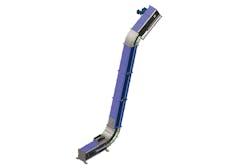Advances in drag conveyor technology put pressure on pneumatic conveyance systems
For years, pneumatic conveyance systems were the best choice to transfer many materials in an enclosed, dust-tight environment. These systems provided, and still do provide, excellent control over contamination and leakage. But rising energy costs and incentives to reduce CO2 emissions have pressured manufacturers to reevaluate these energy-intensive systems. Power is now a factor that manufacturers consider when they choose a conveyor. For this reason — and because advances in technology have enabled mechanical drag conveyors to provide enclosed, dust-tight performance — producers would do well to consider mechanical conveyors over pneumatic systems for many applications.
There are applications where manufacturers will need a pneumatic conveyance system irrespective of power. A process in which contact with the material being transferred needs to be limited, for example, may call for a pneumatic system. The same goes for a process that requires pressure-tight conveyance. Depending on the material and requirements for the route, pneumatic systems may make more sense than mechanical conveyors.
There are also applications for which pneumatic conveyors will never be the best choice. If the conveyance rate is under 2,000 pounds an hour, the distance less than 50 feet and there are two or fewer changes in direction, mechanical conveyors will normally perform better. Similarly, if the conveyance rate is higher than 60 tons per hour and the distance more than 1,000 feet, manufacturers will typically do well in choosing a mechanical system.
The same goes for certain materials. Ash, for example, will turn a pneumatic conveyance system into a sandblaster. Due to the abrasiveness of ash, it will quickly erode equipment. And if material does not completely combust in the boiler, it can catch fire and possibly cause an explosion in a pneumatic system. Mechanical conveyors pose far less risk when handling ash.
To determine which system will work best for your application, you should speak with someone who specializes in material handling.
There are many applications for which either system will work. In fact, the number of applications for which drag conveyors may be used in place of pneumatic systems have increased. Tubular drag conveyors, for example, can provide enclosed, dust-tight performance, as can certain box-style drag conveyors. Mechanical drag systems are also now available with clean-out systems to address contamination. Thus, the argument that pneumatic conveyors are the only way to fully contain and protect material from contamination during transfer is no longer accurate.
Ease of routing is another argument for pneumatic systems that no longer applies. Tubular drag systems can be easily routed around obstacles like pneumatic systems. And box-style drag conveyors are available in modular sections (depending on the manufacturer), which makes rearranging or adjusting the layout of these systems much easier than in the past. Box-style drag conveyors can also be designed with vertical curves; they need not run in a straight path as manufacturers of pneumatic conveyance systems sometimes imply, though it is true they cannot curve horizontally.
In applications where either a pneumatic or mechanical system may be used, drag conveyors have some advantages over pneumatic conveyors. Primary among these is power. Pneumatic conveyance systems typically require five to 10 times the amount of horsepower as comparative mechanical systems. There have been instances in which pneumatic systems require 15 times as much power.
In terms of operational expense, therefore, the difference between these systems can be quite dramatic. As an example, a client was quoted a 60-horsepower pneumatic conveyance system to move chipped wood. Biomass Engineering & Equipment was able to move the same volume of material with three, 3-hp drag conveyors. The difference in operational costs for these systems was thousands of dollars per year.
Another advantage drag conveyors have over pneumatic systems is that they do not require a solid-gas separator or filtration. Cyclones, bag houses and filters are unnecessary.
Further advantages include:
- Simpler controls. Pneumatic systems often require PLC systems to operate. Mechanical systems typically have an Off-On button.
- A broader range of materials. Drag conveyors can be configured to move virtually any bulk material. Pneumatic conveyance systems do best with dry, fluidizable powders.
- Multiple inlets. Pneumatic systems can only accept material from a single source.
- Performance irrespective of elevation. A high elevation above sea level may negatively affect the performance of pneumatic systems because the air is less dense.
- Operation despite a lack of headroom. Pneumatic systems require a large amount of vertical space to accompany the blowers, cyclones and filtering equipment.
- Performance in freezing temperatures. Water vapors going through a pneumatic system that runs outdoors in freezing climates can condense and collect in low-pressure areas. If the water freezes, it can eventually burst the pipe (not to mention restrict the airway, alter the pressure in the system and strain the blower).
A final advantage of mechanical drag conveyors involves emissions. In certain processes, hot materials will give off volatile organic compounds (VOCs) as they cool during transfer. If a producer uses a pneumatic conveyor, the system will emit these VOCs at the blower, which is a measurable point for emissions. This is not the case with mechanical conveyors, as they are not airtight and are not, therefore, measured for emissions (at least in the United States).
In light of developments to drag conveyors, many past reasons for choosing a pneumatic system over a mechanical one no longer hold true. To increase operational efficiency and decrease expenses, producers looking to upgrade or replace their current material handling equipment should consider whether a mechanical means of transport is feasible. If it is, your operation could save thousands of dollars in energy costs every year.
Joel E. Dulin is digital marketing manager for Biomass Engineering & Equipment.
